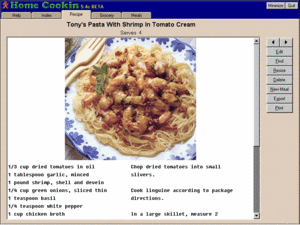There are dozens, if not hundreds, of recipe programs available in stores and online. I have tried many of them and found them lacking primarily because of the import/export capabilities and the resizing of servings, or lack thereof.
The one time I bought a recipe program at a store without trying it I was totally dissatisfied. I determined that I would not buy another program unless I tried it and was satisfied. In my search, I downloaded several demo programs and found all but one lacking. Even then, the program I chose was not perfect, but the issue was so minor as to be unmentionable, though I will mention it later.
The two programs I am comparing are Home Cookin 5.5 by Mountain Software and Cookbook Wizard for Windows 2.0 by MicroBlast Software. Home Cookin is the program I chose to purchase. I chose to compare it to Cookbook Wizard because of the “highest rating” claims on the website. I hadn’t thought much of those claims when I tried it, but they caught my attention when I decided to compare two recipe programs.
The first issue I have had with every program I tried was the importation of recipes. Cookbook Wizard and Home Cookin were the only two that allowed for comparatively easy importing and exporting. I attempted to import to and export from each program.
Exporting from both was relatively painless, although with the Cookbook Wizard you have many options, the first of which is to Export or to Export to Word. That’s fine, but when you choose Export, you then have a choice between Import Ready Format (it doesn’t say for what program), Comma Delimited, HTML Format, and Text Format. It even tells you where they were saved. However, unless the consumer is computer-savvy, Comma Delimited and HTML Format may not mean anything, not to mention Text Format.
When exporting from Home Cookin, it offers Home Cookin format (with photos and text only), Meal Master, Mastercook, XML, Recipe Index (Titles Only), as well as saving it to the clipboard. As with the Cookbook Wizard, XML won’t mean anything to a non-computer-savvy person. Both the Meal Master and Mastercook formats are .txt files.
Importing was a bit of a test in patience. With the Cookbook Wizard, you can use the Import Wizard where you cut and paste from the clipboard or from a .txt file. It will put the data on the left side of the import screen where you will cut/copy and paste or retype the information into the right side in the proper field. To use the import option, you have several options: Cookbook Wizard (Import Ready Format), Recipe Wizard (Recipe Wizard Compressed), Recipe Wizard (E-Mail Format), Meal Master (Dos Ver 8.x), Master Cook II or Master Cook III (MXP Format), Micro Cook (DOS Ver, ASCII Format, 50 C Width), Micro Kitchen Companion Ver 3.0 (MKCW Format), and Micro Cookbook (Ver 5, MXP Export Format). I exported from Home Cookin into Meal Master and Mastercook formats. Mastercook format was incompatible. With the Meal Master, it seemed to import fine, but I can’t find the recipe. However, the .txt file for both programs can be opened and imported using the clipboard, as they are both text files. So, it is possible to import into the Cookbook Wizard, but it is very time-consuming.
With Home Cookin, you can import a document (I exported one recipe from the Cookbook Wizard to Word then imported it into Home Cookin) or you can open the document, then cut/paste into Home Cookin. I exported a recipe, which was saved with a CW extension. Home Cookin brought it in so it would have to be dealt with manually. Manual import looks like a text document. You highlight each part, title, serving size, ingredients, instructions, then click on the appropriate button, title, serving size, etc., then click Save. Voila. Even importing manually, importing with Home Cookin is a lot less time-consuming than the Cookbook Wizard.
The Cookbook Wizard has many different additions such as nutritional values, but those must be input manually, assuming the recipe you are importing has them. If it doesn’t or you are inputting an original recipe, the nutritional value feature is quite useless unless you know how to determine those values on your own. Part of the pleasure of having a recipe program (at least for me) is having everything you need right there. I can down-size a recipe easily. And, I can keep track of my experiments. If I wanted the nutritional value, I would want it there, not have to figure it out before I put the recipe into the program. Unless the program can determine nutritional value based on the ingredients of a recipe, it’s pretty useless. To continue, you can look up spices and see what foods to use them with or look up foods and see what spices to use. This is very handy for someone like me who likes to try new things. The list of spices and herbs has some I’ve never heard of. Recipes can be searched by cuisine or category. You can also print a cookbook in several formats and can sort on multiple criteria. Both programs have categories (Home Cookin calls them Chapters). With both you can produce a shopping list, which you can then edit if you choose. With Home Cookin, meals can be planned months in advance. This is very handy for the busy cook with a family. I would like this feature if I were the planning type. With Home Cookin you also have the ability to run the program from a Flashdrive. That would be handy for me when I want to cook at my sister’s house and bring recipes.
On the surface Cookbook Wizard is better than Home Cookin for a lower price. It has a lot of options that some may find valuable (i.e., nutritional values if they don’t mind not having them for all recipes). Although for importing, I prefer Home Cookin’s ease of use. However, there is one thing that Cookbook Wizard does not have. This was the deal-breaker. You can not change the recipe to account for serving size. If you import a recipe for eight servings, you have to manually calculate the change for each ingredient. Now, Home Cookin isn’t perfect. If I want to change a recipe from 8 to 40, it’s going to tell me to use 10 teaspoons of basil and 20 tablespoons of parsley. In my case, that’s not a deal-breaker. I usually want to decrease a recipe from whatever to one.
If you don’t care about things like that, either program would probably work for you. I am not particularly particular. I just want to be able to import a recipe without having to cut and paste each field or retype the recipe (although in defense of the Cookbook Wizard I’ve tried programs with worse import features), and I want to be able to resize a recipe easily.
Happy cooking.






